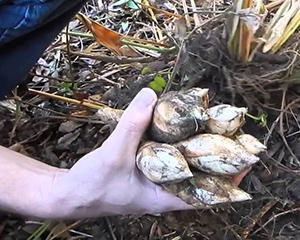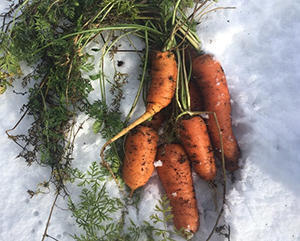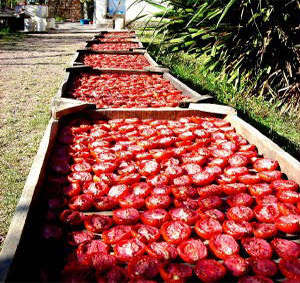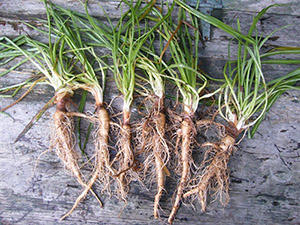Whether you are looking for a long-term food storage solution to become self-sufficient, save money, or want an abundance of home-produce to last until you need it, putting by vegetables for future use is easy and rewarding. To stockpile vegetables, you won’t need to spend money on specialized equipment or be an expert in the kitchen. With planning and common sense, you can take pride in a larder filled with a tasty, nutritious harvest that will last a year or longer.
To keep the roots, leaves, and fruits of vegetables for future consumption, we must prevent decay. While freezing is an option, it depends on electricity and the availability of storage space. Fortunately, there are other efficient and practical ways to stockpile them for prolonged periods.
A word of warning – ripe fruit such as pears and apples give off a gas called ethylene, which stimulates other fruits and vegetables to ripen in turn. It is best not to store fruit near vegetables that are stockpiled for long-term use.
Vegetables That You Can Store for a Year or Longer and How to Do It
#1. Winter squash and Pumpkin
Winter squash and pumpkin are nutritious and can be used in many recipes during the months when fresh vegetables are scarce. Leave a short stub of the stem when you cut ripe fruits from the vine, wipe the pumpkin with a damp cloth to remove soil, and store on open shelves or in baskets in a cool dark room such as a basement.
#2. Arrowroot
 Arrowroot is a water plant with tuber-like roots which grow in soft mud. Compared to other vegetables, arrowroot delivers a meagre harvest and requires some effort to process.
Arrowroot is a water plant with tuber-like roots which grow in soft mud. Compared to other vegetables, arrowroot delivers a meagre harvest and requires some effort to process.
However, it’s an essential addition to your stockpile because of its unique benefits. Because it’s so easily digestible, arrowroot is a suitable food for babies and for adults recovering from a digestive disorder. You can harvest young roots of the plant for eating in spring and early summer. When peeled and cooked, arrowroot tastes like slightly mealy potato. Later in the growing season, the roots become fibrous and inedible and are only good for processing into arrowroot flour.
Peel the roots thoroughly to get rid of the outer layer (it will make your food taste bitter) and pound them to a pulp.
Strain the pulp through a coarse cloth and pour the liquid into a container with a large surface area.
Set the container in the sun or close to a heat source until all the liquid has evaporated and only powder remains.
You can store Arrowroot powder almost indefinitely. For daily cooking, arrowroot powder is an excellent substitute for cornstarch in baking and sauces, and it will make battered fried food deliciously crisp.
#3. Cabbage
The only way to keep cabbage and some other vegetables fresh is to fool them into thinking that they’re still growing. Dig cabbages out of the ground roots and all. Trim the outer leaves and plant each cabbage in a few inches of damp soil or sawdust in a bucket or bin with a lid. Store in the basement; 30 – 45 degrees Fahrenheit is ideal. You can preserve celery and leeks the same way.
Related: How To Make A Mini Root Cellar In Your Backyard In Less Than Two Hours
#4. Carrots
 Like cabbage, carrots are fleshy and will start decaying soon after you dig them up. Throughout summer and autumn, harvest only what you can eat within a few days and leave the rest in the ground.
Like cabbage, carrots are fleshy and will start decaying soon after you dig them up. Throughout summer and autumn, harvest only what you can eat within a few days and leave the rest in the ground.
As soon as winter frost starts damaging the tops of the plants, pull up the rest of the crop to prevent it from freezing in the ground and cut off the foliage. Fill buckets or bins with three to four inches of moist sand, lay carrots horizontally almost to the top, then cover over with another layer of sand.
Store your produce in the basement or garage, and you can pull out fresh carrots throughout winter when you need them. This storage method gave rise to the name ‘root cellar’, and you can store tubers such as sweet potato, cassava and yam in the same way.
#5. Parsley and Celery
Parsley and Celery are varieties of the same Mediterranean plant and you can stockpile them as a vital source of vitamin B and C, iron, and dietary fiber for periods when other nutrient-rich vegetables are scarce.
Most people think of these plants as a leafy seasoning in dishes such as soups and stews, but did you know that all parts of parsley and celery plants are edible? You can enjoy the leaves and stems fresh in salads during the summer, and dried for winter together with other savory herbs.
You can store and use parsley and celery roots in the same way as carrots; when you are ready to eat them, scrape clean with the back of a knife and add the chopped roots to the pot.
Related: The 5 Most Common Edible Weeds In Your State
#6. Jerusalem Artichokes
Jerusalem Artichokes are not only tasty and nutritious, but also easy to grow and each plant delivers a prodigious crop of roots which you can harvest in autumn and store in the same way as carrots.
The plants are a type of indigenous North American sunflower and even when planted in pots, the roots will develop well. For the most nutritional benefit, boil Jerusalem artichokes in the skin, like jacket potatoes, and peel once cooled. They can also be fried or used to thicken soups.
#7. Tomatoes
 Italians call tomatoes the ‘essence of summer’ and there’s nothing better to add flavor and color to food on cold winter days. Cut ripe tomatoes in half lengthways and lay down well-spaced on suspended netting to make sure that there’s good airflow around the fruit. You can dry tomatoes in direct sunlight.
Italians call tomatoes the ‘essence of summer’ and there’s nothing better to add flavor and color to food on cold winter days. Cut ripe tomatoes in half lengthways and lay down well-spaced on suspended netting to make sure that there’s good airflow around the fruit. You can dry tomatoes in direct sunlight.
Turn the tomatoes every day for three to seven days until they’re evenly dehydrated.
Dried tomatoes can be stored in a cool place in airtight containers for six months, or up to two years if you layer them in oil in sealed containers. You can also preserve mushrooms and onions in this way.
Related: If I Could Only Stockpile 10 Foods
#8. Potatoes
Unlike carrots, once a potato harvest is ready, it needs to be dug up, washed and stored at once. This is not a job you can leave until the frosts start; potatoes need to cure before you can stockpile them. Store the potatoes in cardboard boxes or paper bags at temperatures between 45 and 60 degrees Fahrenheit and 80 – 100% humidity for a week. During this period the potatoes’ skin will thicken, preserving them for future use.
After 7 to 14 days, you can transfer the potatoes to a dark, cool room such as a basement for long-term storage. Be careful to discard any potatoes with soft spots, broken skin, or other blemishes. Like the proverbial rotten apple, one spoiled potato will start a chain reaction in your stash.
#9. Onions
Suspend your onion crop from the ceiling. Air can circulate between hanging onions, and it prevents excess moisture from causing rot. A string of braided onions is not only practical but looks beautiful in a corner of your kitchen.
Harvest onions on a warm, dry day and let them cure for up to a week by spreading them out in a single layer on the ground. Once the tops have wilted but before they become dry and brittle, braid the onions into a string. Tie off the top with a piece of twine, which you can use to hang them. Garlic can also be stockpiled this way, and a corner of the pantry or the basement is a good place to store them.
#10. Salsify
 Never heard of it? That’s probably because it’s such an ugly-looking root. In the age of photogenic food, it’s fallen out of vogue, but during the 18thand 19th century, salsify was a staple in the US and Europe, and today it grows wild on uncultivated land.
Never heard of it? That’s probably because it’s such an ugly-looking root. In the age of photogenic food, it’s fallen out of vogue, but during the 18thand 19th century, salsify was a staple in the US and Europe, and today it grows wild on uncultivated land.
Salsify is a hardy relative of the dandelion, easy to grow, and the roots are resistant to disease and most  pests. It’s a good source of dietary fiber, vitamins B and C, and minerals such as iron, calcium, and potassium. As a bonus, you will probably love to eat this taproot.
pests. It’s a good source of dietary fiber, vitamins B and C, and minerals such as iron, calcium, and potassium. As a bonus, you will probably love to eat this taproot.
Greengrocers call salsify the oyster plant and compare the taste to sea mollusks. The flavor intensifies the longer you store it. Stockpile salsify roots in the same way as carrots.
Source: askaprepper.com
Read also:
The Beginner’s Guide To Companion Planting
How To Live Off Grid For Under $3,000
How To Make Yeast For Long-Term Storage
24 Lost Gardening Tips from 100 Years Ago
Back To Basics: 4 Types Of Homemade Cheese
Planning To Retire Off-grid? Here’s Where To Relocate
25 DIY Root Cellar Plans & Ideas to Keep Your Harvest Fresh Without Refrigerators
Recommended Books
THE LOST BOOK OF REMEDIES-All Medicinal Plants and Lost Cures of North America
THE LOST WAYS-Learn the long forgotten secrets that helped our forefathers survive famines,wars,economic crisis and anything else life threw at them
EASY CELLAR-AMERICA’S NATURAL NUCLEAR BUNKERS: FIND THE CLOSEST ONE TO YOUR HOME
THE LOST WAYS 2-This lost super-food will bulletproof you against any food shortage or famine
BLACKOUT USA-EMP survival and preparedness guide
DIY HOME ENERGY-Follow the step-by-step guide from A to Z and you will have a working system to reduce your electricity bills and save energy
MY SURVIVAL FARM-This hidden survival garden will keep you well fed when SHTF
MEAT FOR LIFE -THE REAL HOMEMADE AND HEALTHY MEATY TREATS OUR GRANDPARENTS USED TO MAKE…


One Reply to “10 Vegetables That You Can Stockpile Without Refrigeration For A Full Year”